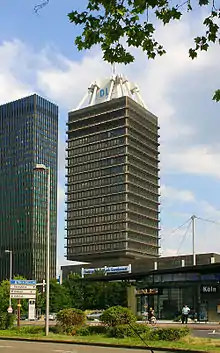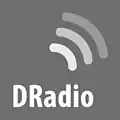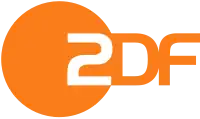Deutschlandradio
Deutschlandradio (DLR; Radio Germany) is a national German public radio broadcaster.
 Headquarters in Cologne | |
| Type | Public-service sound broadcasting |
|---|---|
| Country | Germany |
Broadcast area | National |
| Headquarters | Cologne |
| Programming | |
| Language(s) | German |
| Ownership | |
Key people | Stefan Raue, Chairman |
| History | |
| Launch date | 1994 |
| Coverage | |
| Stations |
|
| Links | |
| Webcast | List of streams |
| Website | www |
History
Deutschlandfunk was originally a West German news radio targeting listeners within West Germany as well as in neighbouring countries, Deutschlandfunk Kultur is the result of a merger of West Berlin's RIAS station and East Berlin's DS Kultur after German reunification.[1] Both networks that used to broadcast mainly on the AM bands have since spread throughout Germany, having been allocated many additional FM transmitters. However, because of lack of analogue frequencies, during 2003 Deutschlandradio changed its distribution strategy to digital terrestrial transmission.
Stations
It operates four national networks:[2][3]
- Deutschlandfunk: mainly news and information
- Deutschlandfunk Kultur: culture in a broader sense
- Deutschlandfunk Nova: aimed at young adults, mainly spoken-word
- Dokumente und Debatten: opt-out channel, often for special events
Dokumente und Debatten is a digital-only special-event channel. It broadcasts coverage of the federal parliament, sports events, talk shows and shipping forecasts. Many of the talk shows are rebroadcasts of the audio portions of TV shows made by ARD, ZDF or Phoenix.[4] It uses digital frequencies of both Deutschlandfunk and Deutschlandfunk Kultur.
Deutschlandfunk Nova is knowledge orientated station, started in 2010 as DRadio Wissen, targeting a younger audience, and broadcast only digitally – via satellite, cable, DAB, and online.
Deutschlandradio is based in Cologne, with some departments—including Deutschlandfunk Kultur—based in Berlin.
Branding
On May 1 2017, DRadio Wissen was renamed Deutschlandfunk Nova, Deutschlandradio Kultur was renamed Deutschlandfunk Kultur.[5][6]
Distribution and transmitters
The three programs and the additional special event channel are all distributed terrestrially via Digital Audio Broadcasting (DAB+) on a nation-wide single frequency network (SFN) in VHF channel 5C. The coverage at the end of 2019 is for portable indoor reception 85% of the population and for mobile reception 96% of the area of Germany or 99% of the highways respectively.
For an intermediate time the two programs Deutschlandfunk and Deutschlandfunk Kultur are still transmitted in analog way via FM with an average coverage of 64% of the area. The switch over from analogue to digital started in 2015 with the switch-off of medium wave and long wave. In 2018/2019 first small-power FM transmitters were switched-off two. The aim is to further improve the digital terrestrial coverage of DAB+ and to reduce the analogue transmission step by step. For stationary reception the programs are also distributed via satellite on the transponder of ZDF.
Of course the programs are streamed via the internet and available on relevant platforms. Beside the linear programs extensive non-linear content is available via audio-on-demand (podcast, mediathek and various platforms). Deutschlandradio is also very active in social media networks in order to make the content available to all public.
Orchestras and choirs
Deutschlandradio has a 40% share in Rundfunk Orchester und Chöre GmbH, a non-profit organisation which operates:[7][8]
- Berlin Radio Symphony Orchestra (East Berlin)
- Deutsches Symphonie-Orchester Berlin
- Berlin Radio Choir
- RIAS Kammerchor
The other shareholders are the Federal Republic of Germany (35%), the State of Berlin (20%) and RBB (5%).
Logo history
- Development of the Deutschlandradio logo
 Logo until March 2005
Logo until March 2005 Logo until May 2010
Logo until May 2010 Logo from June 2010 (from 2012: alternative Logo)
Logo from June 2010 (from 2012: alternative Logo) Former icon (2012–2017)
Former icon (2012–2017) Logo until 30 April 2017
Logo until 30 April 2017 Logo since 1 May 2017
Logo since 1 May 2017
References
- "Geschichten vom RIAS – Inspiriert vom amerikanischen Freiheitsversprechen". Deutschlandfunk Kultur (in German). 13 April 2021. Retrieved 13 April 2022.
- "Institution – Deutschlandradio –". miz.org (in German). 23 September 2020. Retrieved 13 April 2022.
- Schleider, Tim (16 October 2016). "Deutschlandfunk und Deutschlandradio Kultur: Radio, das sich noch lohnt". Stuttgarter Zeitung (in German). Retrieved 13 April 2022.
- World Radio Television Handbook (WRTH), pp. 209–211, 2007 edition, and pp. 194–195, 2008 edition
- "Deutschlandradio-Programme bekommen neue Namen". Die Welt (in German). 26 April 2017. Retrieved 13 April 2022.
- ""Wir brauchen eine klare Absendermarke"". Deutschlandfunk (in German). 13 April 2021. Retrieved 13 April 2022.
- "Rundfunk Orchester Chöre Theater aus Berlin in der Firmendatenbank wer-zu-wem.de". wer-zu-wem.de (in German). Retrieved 13 April 2022.
- "News – 18. Febr. 2009 – Mehr Geld für Rundfunk Orchester und Chöre GmbH Berlin". miz.org (in German). 18 February 2009. Retrieved 13 April 2022.
Further reading
- Fischer, Stefan (28 February 2022). "Deutschlandradio: Intendant Raue steht vor der Wiederwahl". Süddeutsche.de (in German). Retrieved 13 April 2022.
- "Einstimmig wiedergewählt: Stefan Raue bleibt Intendant des Deutschlandradios". FAZ.NET (in German). 3 March 2022. Retrieved 13 April 2022.
